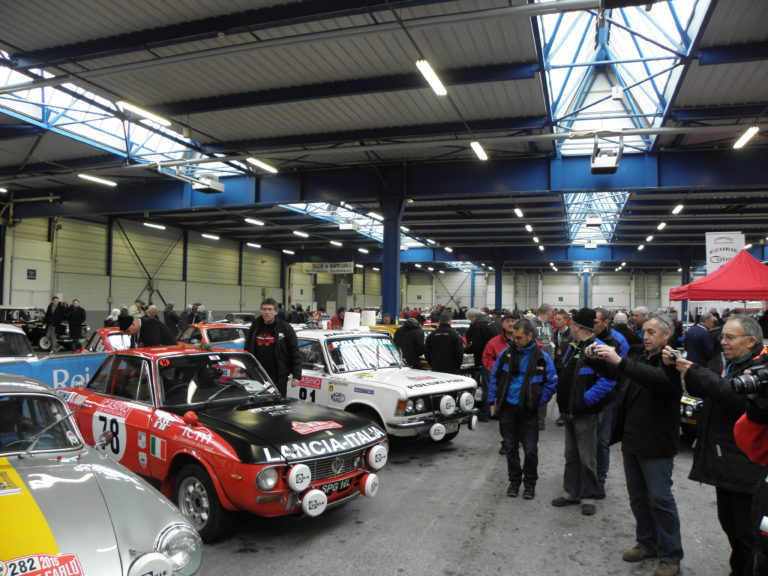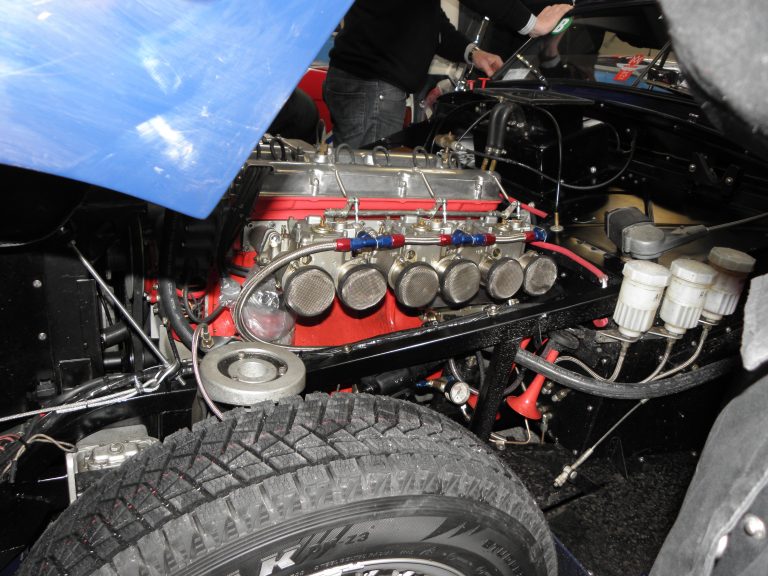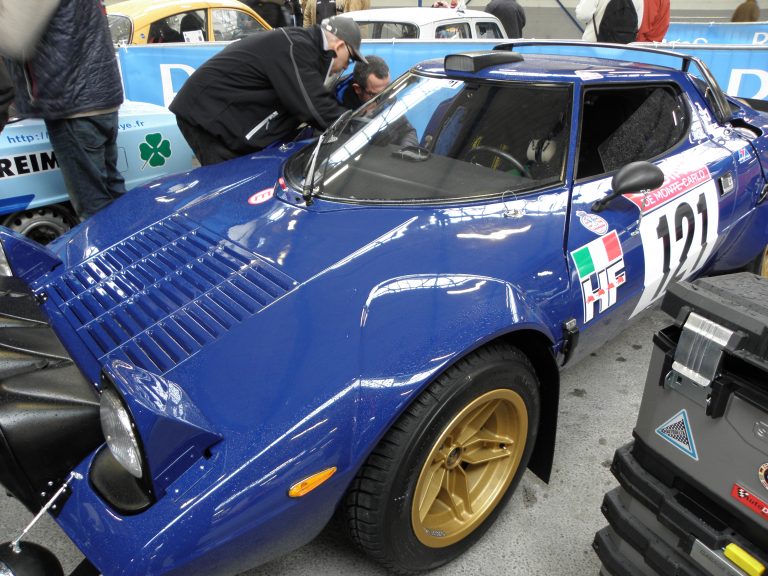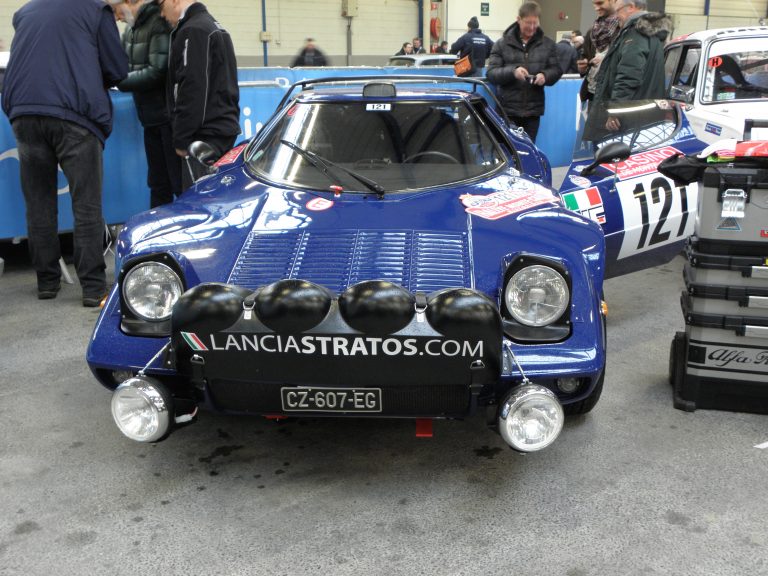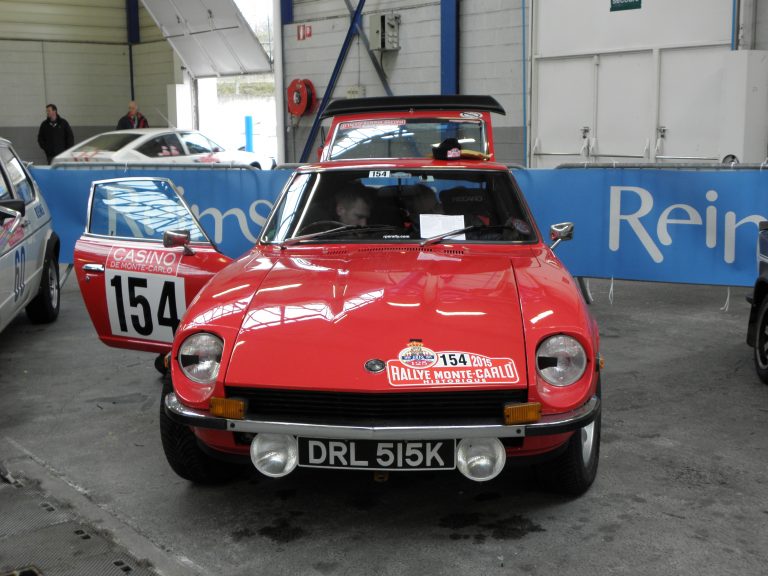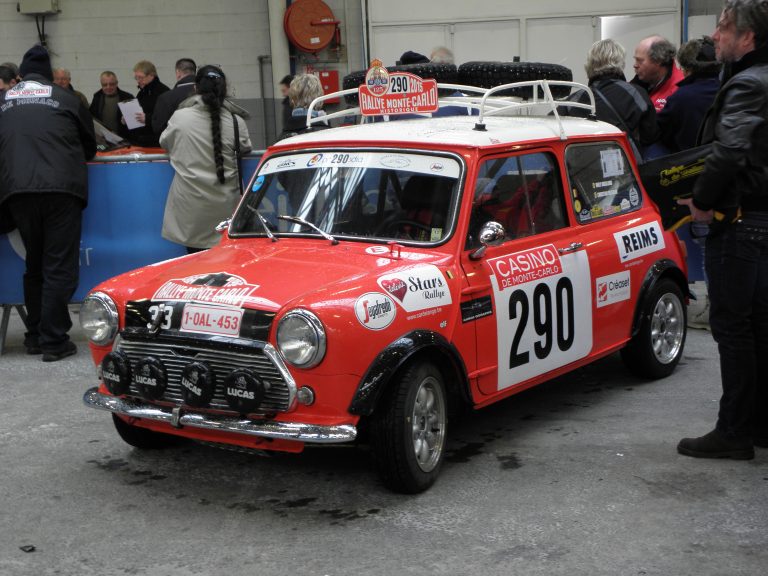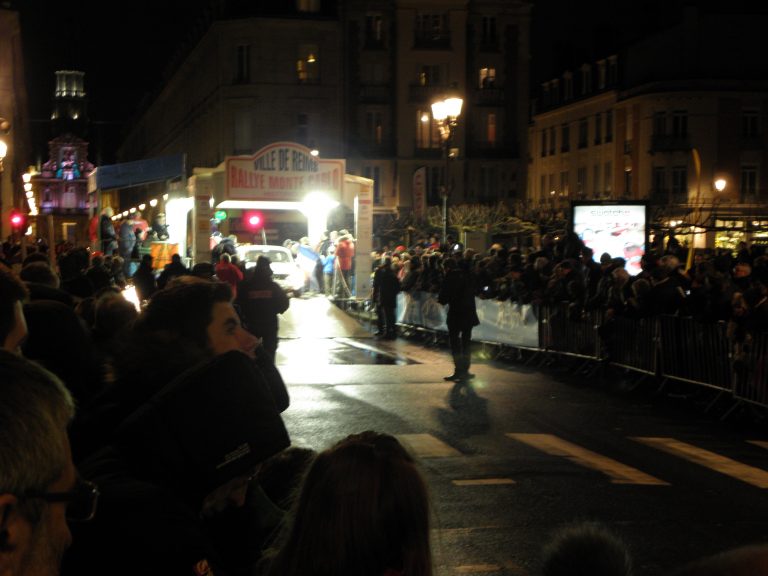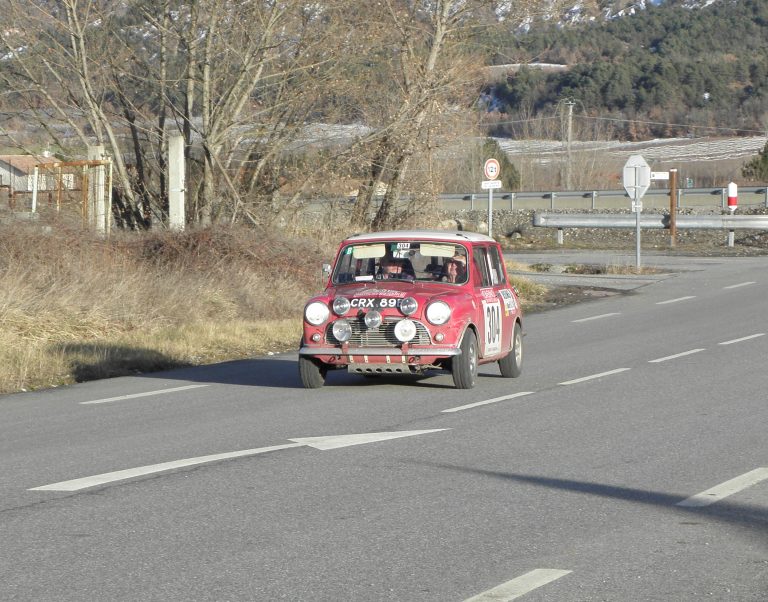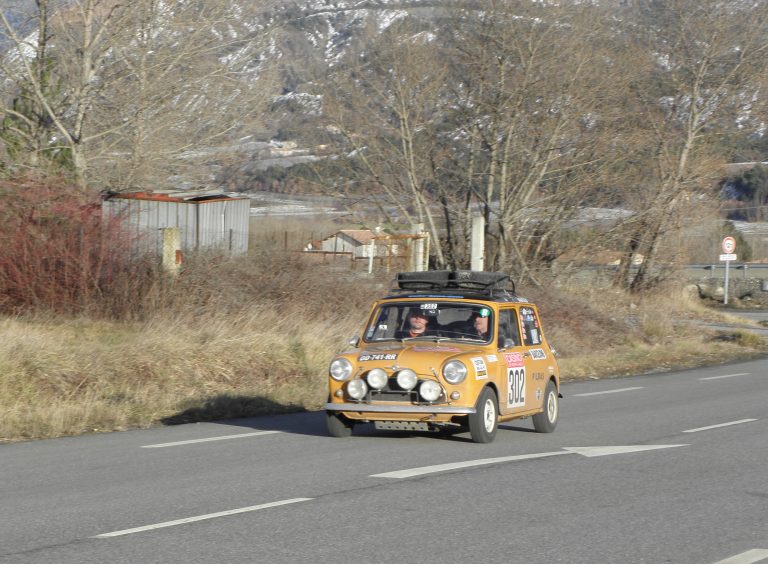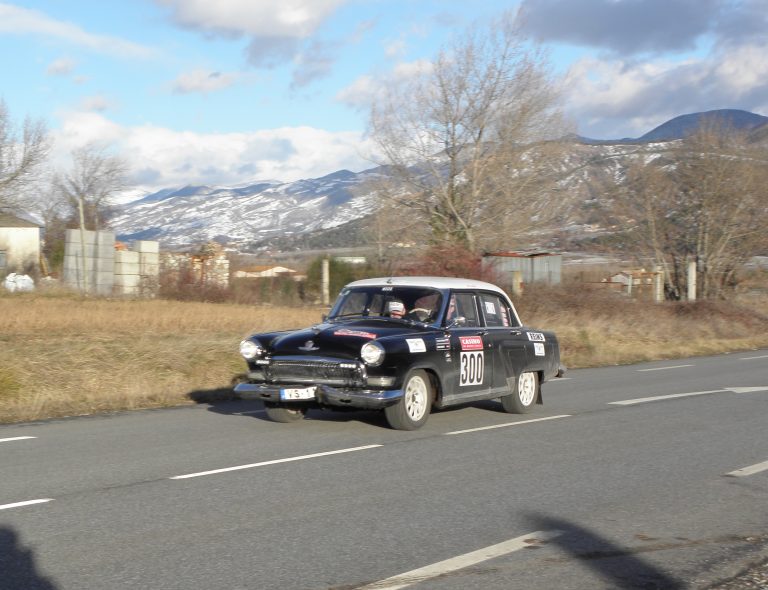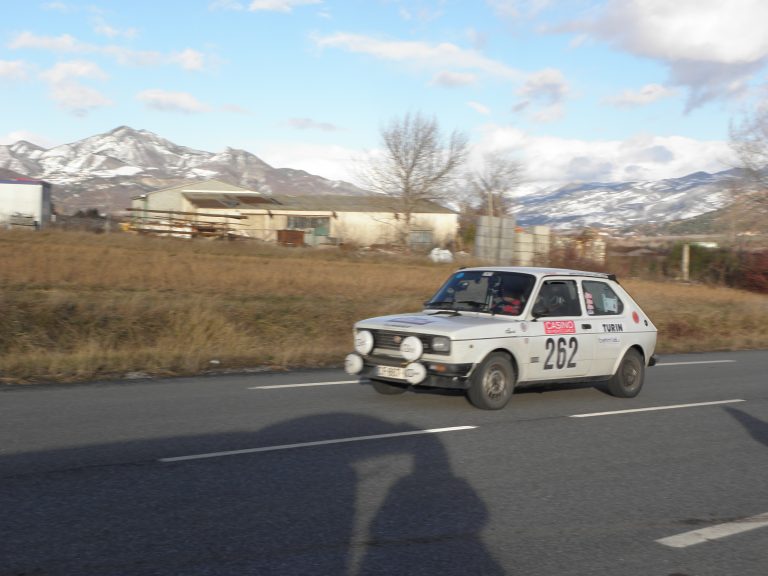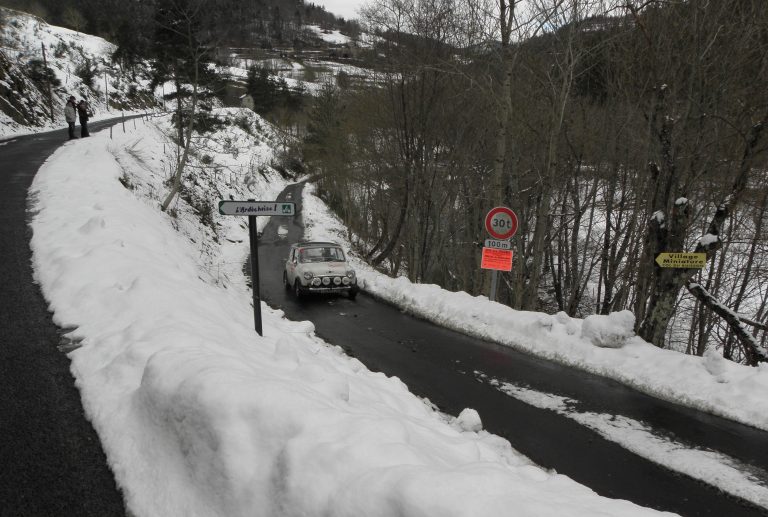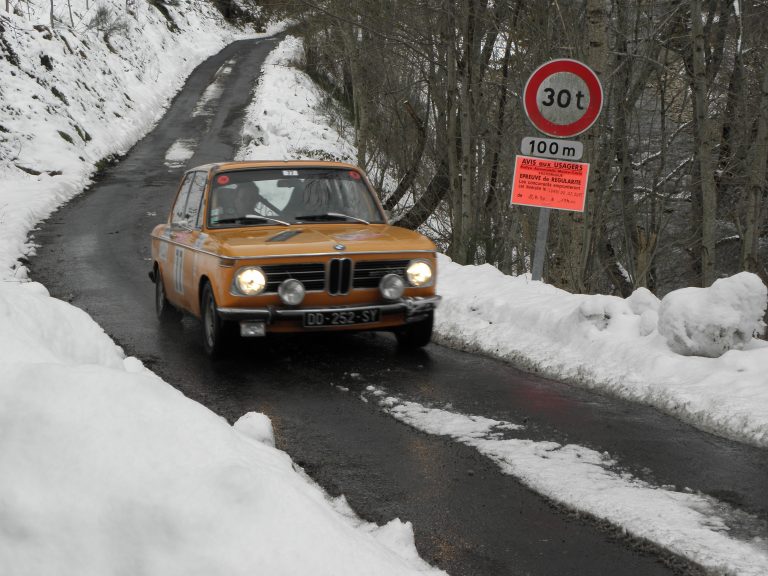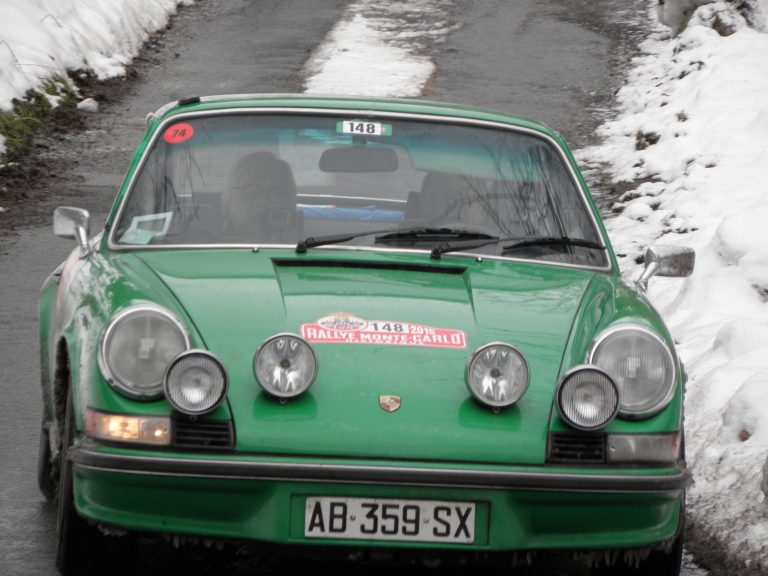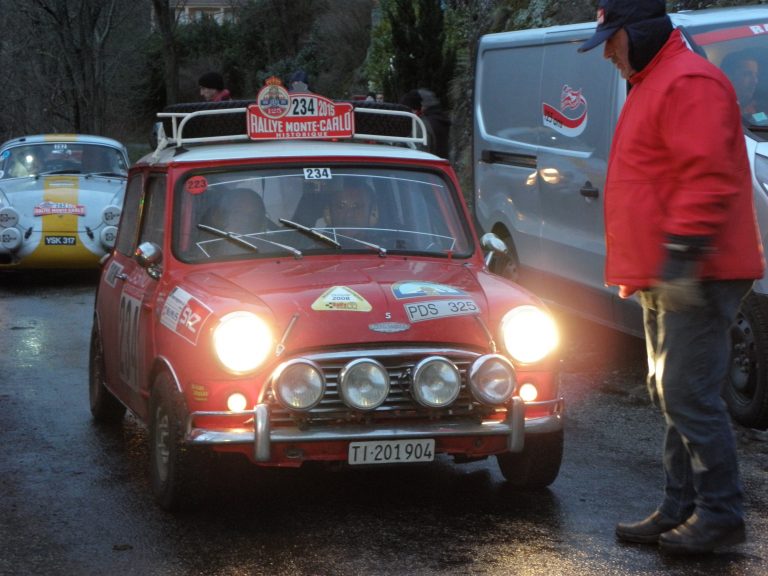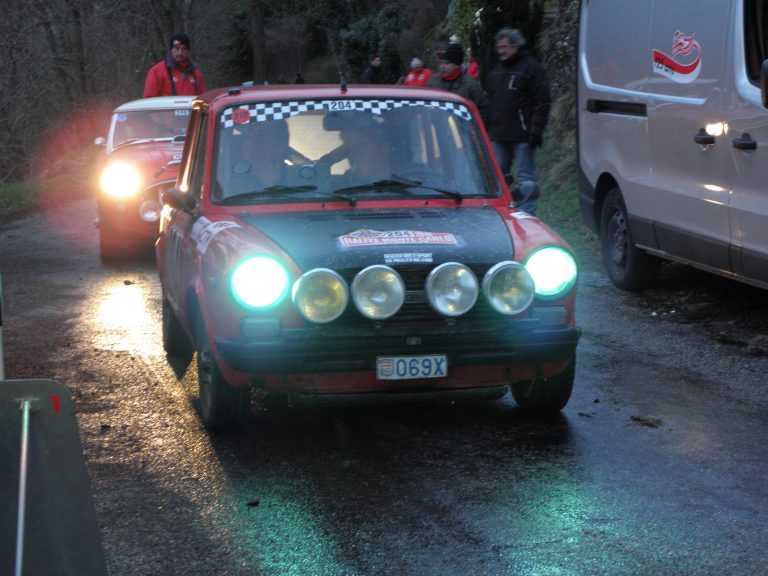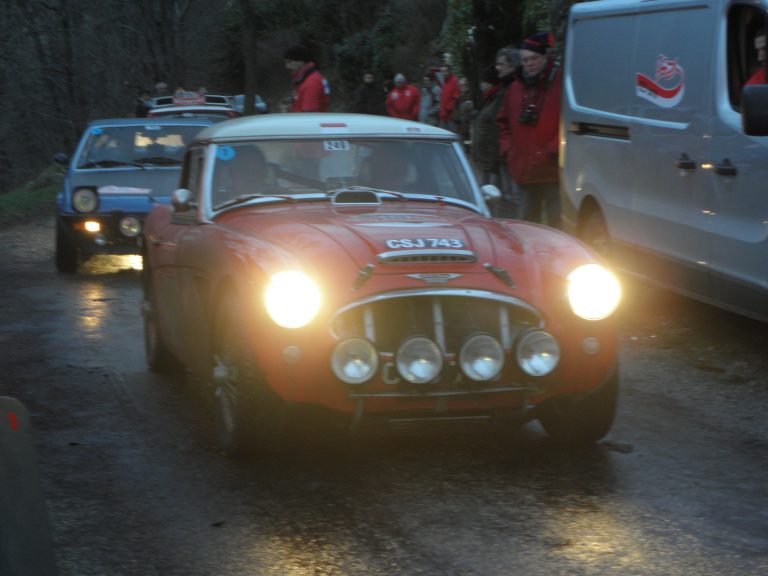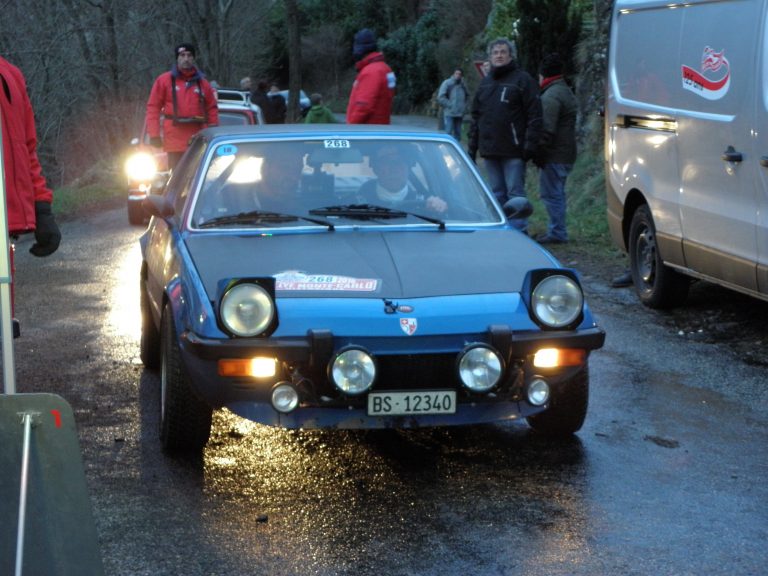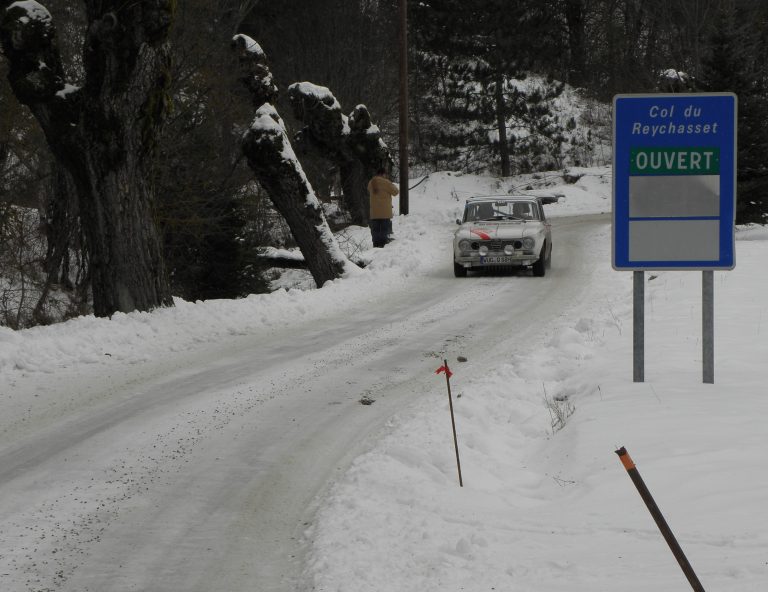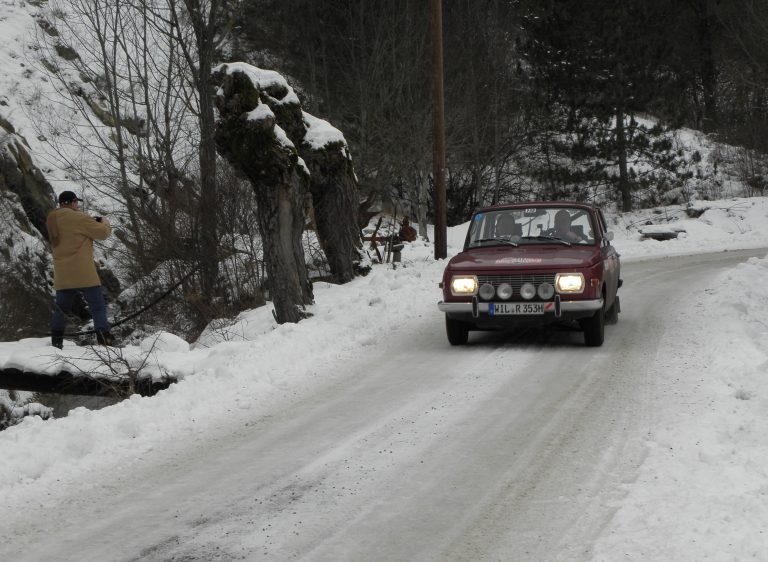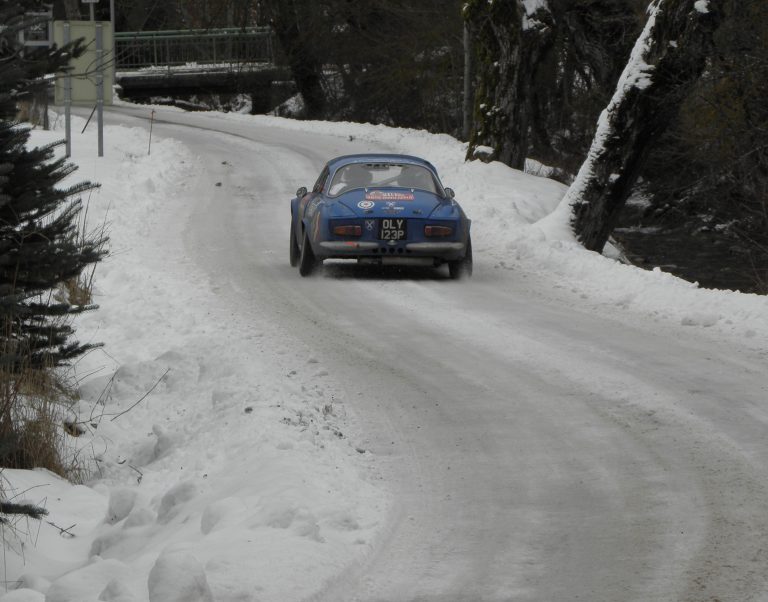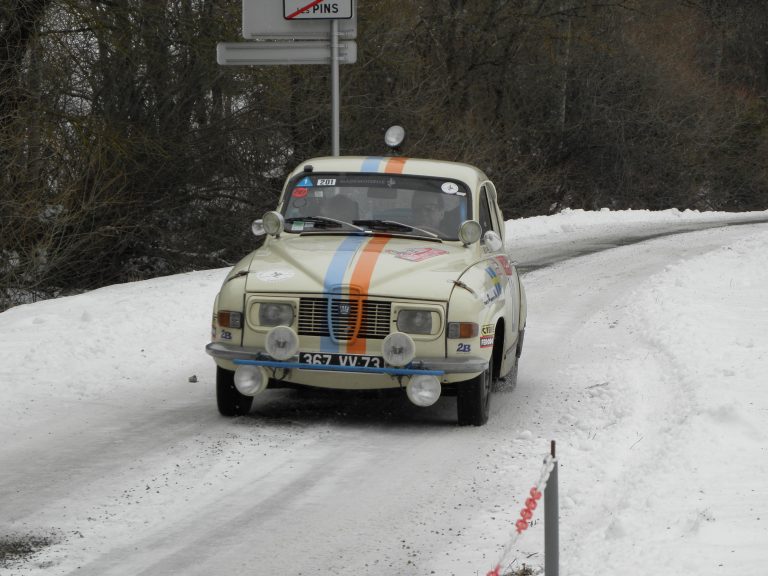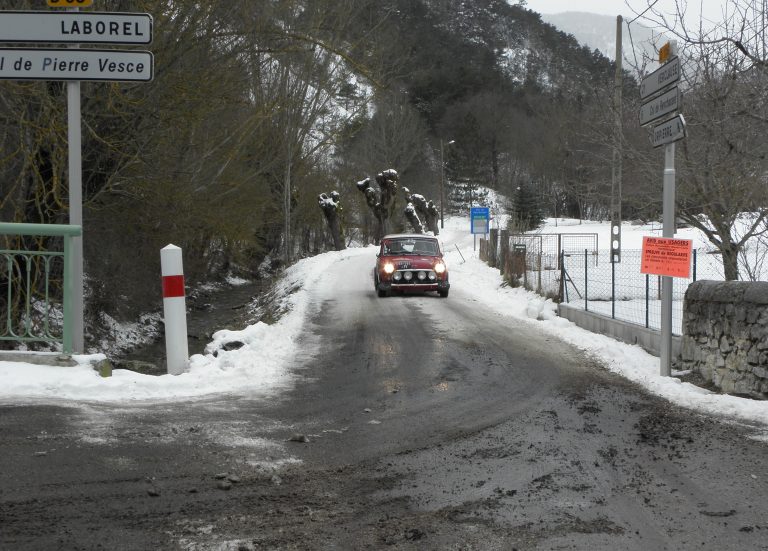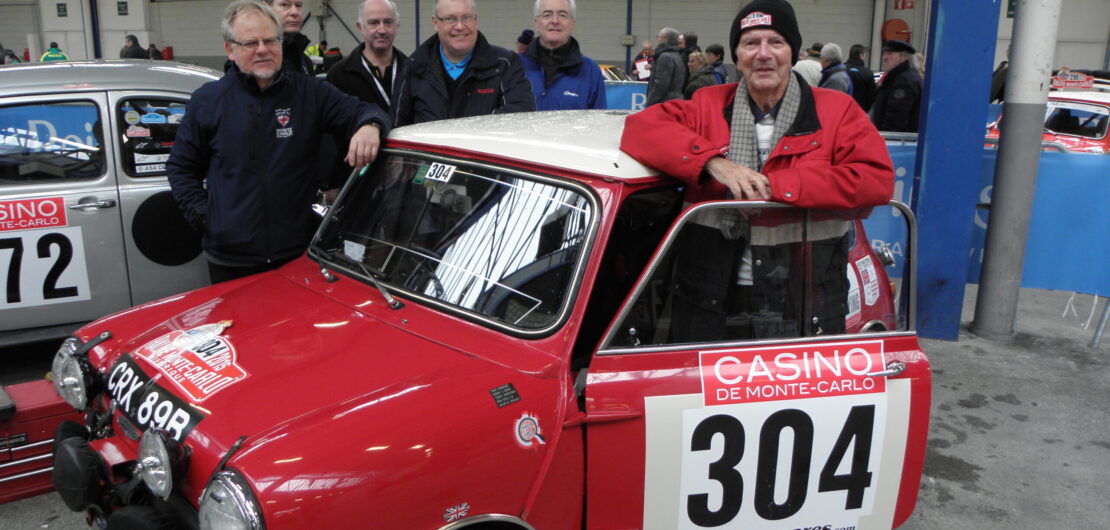
By Chris Paton
The Monte-Carlo Historique is a gentle Sunday run round some nice hotels and cafes for old people in old cars, right? Never having entered a ‘Regularity Event’ that’s what I thought it would be. When I was asked by Michael Hyrons, who is hoping to take part in the rally one day in his restored Cooper-S, if I would like to go to France to find out more about the rally, the idea sounded quite appealing. Michael contacted Alistair Vines and asked if we could tag along with him and his team in their entry in the Mini Cooper-S CRX89B. The initial plan was that this would be a fact finding mission to establish what is required to complete the course. A couple of weeks before the event Alistair asked us if we could carry some spare wheels and fuel to do remote service, and by running ahead of him on the route we could relay back road condition information. When we received the second issue of the service schedule there was an additional column with our instructions and the heading ‘Ice Car’.
A little Explanation
Some detail here about the Monte-Carlo Rally and how the Automobile Club De Monaco ran things. There were five different starting points. These included Glasgow, Copenhagen, Barcelona, Turin and Reims. Eventually all these ‘Concentration Routes’ converged at Saint-André-les-Alpes on Saturday, 31stJanuary to take a route which would include the first Regularity Zone (ZR) en route to Monaco. Timing was to the minute with a set time between main controls. Once the cars reach Monaco they were fitted with a GPS tracker called a ‘Tripy’ which allowed the AC de Monaco to track where and what speed each car was doing. Heavy penalties were applied for exceeding a speed limit and all road sections had a target time between main controls. Between main controls there could be Regularity Zones or ZRs as they were called. The ZR was a regularity section with the aim of achieving an average speed throughout the route. The Tripy allowed ACM to calculate the average speed at several points on the route and award penalties for each point of measurement. That meant that you could not fly through the ZR and then wait near the finish to clock in at your target time. Penalties were awarded per 1/10th of a second early or late on a ZR section. In all there would be 14 ZRs over the whole “Common Route”. After they reached Monaco and had their Tripy fitted they proceeded, after a nights rest, to Valance. Then a loop back to Valance, then back to Monaco for the final couple of sections. [Details of the Sections and ZRs can be seen in the Appendix below, along with links to the ZR routes, etc]
On Wednesday 28th January at 7.00hrs Michael and I set off from Lanark in Michael’s Skoda Octavia VRS which was shod with Pirelli 210 snow tyres. We had a brief stop at Alistair’s house in the Midlands to pick up six wheels and tyres and a small jerry can for spare fuel and then headed for Dover to check into the hotel.
The following morning at the P&O ferry terminal we met Alistair and co-driver Willy Cave along with Nigel and Simon who were on servicing duties. CRX89B was on the trailer ready to board the boat bound for Calais. Michael had done all the planning and paperwork for the trip and I was to do all the driving in France. The journey from Calais to Reims was straightforward and we were checked into our hotel by late afternoon.
We awoke on Friday morning to discover a light covering of snow. We took the car off the trailer and gave it and the Land Rover Discovery service car a quick wash in preparation for applying sponsors stickers. Next we did a trial fit of the snow chains on the VRS and also on the Mini.

On Wednesday 28th January at 7.00hrs Michael and I set off from Lanark in Michael’s Skoda Octavia VRS which was shod with Pirelli 210 snow tyres. We had a brief stop at Alistair’s house in the Midlands to pick up six wheels and tyres and a small jerry can for spare fuel and then headed for Dover to check into the hotel.
The following morning at the P&O ferry terminal we met Alistair and co-driver Willy Cave along with Nigel and Simon who were on servicing duties. CRX89B was on the trailer ready to board the boat bound for Calais. Michael had done all the planning and paperwork for the trip and I was to do all the driving in France. The journey from Calais to Reims was straightforward and we were checked into our hotel by late afternoon.
We awoke on Friday morning to discover a light covering of snow. We took the car off the trailer and gave it and the Land Rover Discovery service car a quick wash in preparation for applying sponsors stickers. Next we did a trial fit of the snow chains on the VRS and also on the Mini.
At 11.00hrs we were off to scrutineering in a massive building full of amazing old rally cars which made it feel like a time warp back to the 1960s. The crew signed on and dealt with the paperwork and we all helped with the last minute preparation for scrutineering. After successfully passing we had a late lunch and then a couple of hours sleep in the car.
Scrutineering at Reims
Fri 30, Sat 31 Jan : “Reims – Le Puy-en-Velay” (127 cars)
The concentration run from Reims to Monaco included those crews who started from Glasgow making up a total field of 127 cars. Our car was running right at the back of the field at number 304 so our start time was 21.00hrs. Our brief in the ice note car was to run 10/15 minutes ahead of the rally car so that we could alert the crew of any adverse weather conditions or road blockages.
The first section was from Reims via passage controls at Gueux, Vitry-le-Francois, Bar-sur-Aube to the main control at Le Puy-En-Velay. Distance 614 Km. Target time 12Hrs 14Min. In theory it should be very easy to do the 614 Km in the time allowed, but as well as the delays at the passage controls there were also fuel stops and general servicing to be done, and also the unpredictable weather to be taken into account.The route was over a mixture of what would be A,B and C roads in the UK and even well after midnight there were people standing out in every village to see and hear the cars passing through. The roads were mainly free of snow and ice, but under the watchful eye of the very experienced Willy Cave, Alistair was really having to press on to keep to the schedule.First fuel service was at Bar Sur Aub just after midnight. We waited for CRX and helped with servicing and then followed to Brion Sur Ource. From there it was a long slog down to Autun, and after 349Km we helped with another fuel service and changed CRX onto studded tyres in preparation for the smaller roads and the higher ground we were approaching.
The route was over a mixture of what would be A,B and C roads in the UK and even well after midnight there were people standing out in every village to see and hear the cars passing through. The roads were mainly free of snow and ice, but under the watchful eye of the very experienced Willy Cave, Alistair was really having to press on to keep to the schedule.
First fuel service was at Bar Sur Aub just after midnight. We waited for CRX and helped with servicing and then followed to Brion Sur Ource. From there it was a long slog down to Autun, and after 349Km we helped with another fuel service and changed CRX onto studded tyres in preparation for the smaller roads and the higher ground we were approaching.
From there we were following the rally car on main roads to Roanna via Digoin. As we approached Roanne the snow came on heavily. We had to stop a couple of times to help clear the build-up of snow on the lamps and the screen on CRX as Alistair was having difficulty seeing the road.
Between Roanne and Feurs the snow was so heavy that the only cars moving were rally and service cars and on the N82 a number of lorries had simply come to a halt on the main carriageway as it was too dangerous for them to continue. But we had a schedule to keep to so following CRX at speed was the only option.
Leaving Feurs we were heading into the mountains on snow covered minor roads and with another 100Km to go it started to get light.
At 08.45hr we reached the main control in Le Puy En Velay. The rally had taken over the snow covered town square and there were many interested locals watching Nigel and Simon check the car over and do a full service of fluids, tyres and fuel. Meanwhile I was trying to grab some sleep in the VRS, but despite having been up for more than 24 hours the adrenalin in my system kept me wide awake.
The Copenhagen crews joined our route here ready to tackle the second section from Le Puy-En-Velay via Sederon to St Andre Les Alpes. Distance 342 Km. Target time 6Hrs 53Min.
This part of the route should have been fairly easy, starting with a very long run over the N102 through Aubenas to Montelimar, but we were in fairly busy Saturday morning traffic so progress was somewhat restricted. This was one of the few opportunities we had to see some of the rally cars as we travelled in convoy with an Alpine Renault A110, a Porsche 356 SC, a Lancia Fulvia Zagato and a Simca 1100 Rallye. From Montelimar we then headed down to Nyons, then over the Col De Peyruergue to the PC at Sederon and then through Sisteron on to the N85 and the N202 to arrive in St Andre Les Alpes at 15.30hrs.
Sat 31 Jan – “St Andre les Alpes – Monaco”, Includes ZR 1 Common route for all 314 cars after their ”concentration runs”
The Turin and Barcelona crews joined the route here making a total field of 314 cars to tackle the third section which would take us to Monaco via ZR1 (the first regularity section). Distance 138Km. Target time 3hrs 15min.
Our tasks in the ice note car was to get well ahead of CRX and drive up the mountain road to the end of ZR1 at Levens village and report back on the road and weather conditions. The ZR was 12Km long on the M19 from Saint-Jean-La-Riviere to Levens. We were able to report back that the weather was cold but dry and there was no evidence of snow or ice. These regularity sections are timed to a fraction of a second with the aim being to maintain a constant average speed for the entire route. Alistair and Willy emerged from the ZR looking very pleased at having set a time only 1.1 seconds over target, helped by the correct tyre choice.

From there we followed CRX down the mountain and as night fell we joined the A8 to Monaco where we met Nigel and Simon at a layby just off the motorway. We managed a final service of the car here before continuing into Monte-Carlo.
The rally crews had to proceed to the Beach Hotel in Monaco to the Tripy distribution zone where the satellite tracking device would be fitted to the cars. This would allow the AC de Monaco to monitor the exact position and speed of each rally car for the rest of the event.
Nigel who had towed the trailer all night went to find the trailer park and we headed to our hotel for a very welcome meal and a comfortable room for the night.
Sun 1st Feb – Start of Classification legs: “Monaco – Valance” Includes ZR2, ZR3, ZR4 and ZR5
The Sunday run was from Monaco to Valence. Section one was to Gare de Clelles. Distance 381Km. Time 8hrs. The one advantage of running at number 304 was that we did not have an early start on the Sunday morning, so at 10.00hr we set off to ZR2 to check road conditions and weather. We were able to report back to Alistair and Willy that the weather was fine and the roads were dry


We then set off on the long drive to ZR3 at Selonnet where we found a way into the middle of the ZR route to find the road covered in hard packed snow and ice. We had travelled 230Km since we left Monaco and Alistair and Willy were due to arrive at 15.00hr. We waited to make sure Nigel and Simon arrived safely at the service area and reported the road conditions to them before setting off to get ahead of CRX to be able to meet them 60 Km away at Monetier-Allemont for emergency service. The service area was on the D942 just across the A51 from Montier-Allemont about 25Km north of Sisteron.
Remote Service
The rally car was due at 17.00hrs. Nigel and Simon arrived 20 minutes before them and as CRX approached all seemed fine but when Alistair stopped the car he announced that they had had an accident. On a narrow road behind local traffic another competing car, in an attempt to overtake, had rammed the rear left hand corner of CRX. Alistair appeared very calm under the circumstances and a quick inspection showed there was no damage to the suspension or the fuel tank. However the bumper was destroyed, the lamp lens was broken and there was considerable damage to the aluminium boot lid. Temporary repairs were made using tape and we set off in convoy towards Gare de Clelles.
As we climbed to an altitude of 1200M the snow was really coming down and the “chains compulsory” signs were on as we approached the Col de la Croix Haute. Our instruction was to take the D539 over the Col de Grimone to rendezvous with CRX at Chatillon after ZR4 (Col de Menee) in case tyres or fuel were needed before tackling ZR5. As night fell we arrived in the small village of Chatillon where we had a long wait in -5 degrees C.
When Alistair and Willy arrived no service was required and we followed them towards ZR5, but as we turned off the main road in the village of Die the snow was so heavy that there were no tyre tracks visible on the road and we wondered if the route was closed. We decided to continue and Alistair was pressing on at speed so we had to follow suit up the incredible Col de Rousset with very thick snow on the road and snow banks at least one metre high on either side. At the summit we had to bear right as Alistair took the left fork to head to ZR5 which went over the Col de Carri and the Col de l’Echarasson. We met Nigel and Simon at Saint-Nazaire-En-Royans to wait for CRX and then travelled in convoy to Valence arriving at 21.30hrs.
Mon 2nd Feb – 1st part of the Common leg: “Valance – Valance”. Includes ZR6, ZR7, ZR8 and ZR9

Monday morning in Valence was cold but sunny and on paper the ‘Valence to Valence’ route looked like a fairly easy day ahead for us. The first section from Valence to Saint Agreve was a distance of 234Km and a target time of 5hrs30. We set of at 10.30hrs to make our way to the ZR6 at Saint-Pierreville to be there at least half an hour ahead of Alistair and Willy to relay back the road conditions, snow line height and weather. We arrived in the village to find that the roads were dry and there had been very little snow all the way there. After reporting back to the crew we set off to La Champ Raphael to report the conditions for ZR7 Burzet to Saint-Martial. This region appeared to have had no recent snow because despite there being a good covering at the side of the road, the roads were clear and dry.
Saint-Agreve ZR8
There was a major service at Saint-Agreve but first we had to go to ZR8 to check weather and road conditions. The ZR started at the Col du Faux and came back round towards Saint-Agreve finishing at Labatie d’Andaure. We made our way to a cross roads in the middle of the rally route to again find there was no snow or ice on the road and we actually had some spare time to watch several rally cars passing by here. Doing Ice Notes and Remote Service is quite a lonely task as you rarely see your rally car or service crew, but just outside Saint-Agreve there was a handy car park where several crews including Nigel and Simon had set up. We had some time in hand so we met them there to enjoy a hot coffee made by Nigel in the back of the Land Rover and to compare notes with the other service crews on how well or otherwise things were going for their crew.
The next section was from Saint-Agreve to Tournon. Distance 120Km. Target time 3hrs. We left service before Alistair and Willy arrived, and while they were in service and then tackling ZR8 we had a relatively easy run along the D533 and through Lamastre and into a junction in the middle on ZR9. Again there little or no snow to report so we returned to Lamastre to wait for Nigel and Simon to report the conditions.
Start of ZR9 Lamastre to Plats
The start of ZR9 was right beside the service park so we were able to walk up to watch the some of the cars leaving. It was getting quite dark when Alistair and Willy arrived and after a very brief service they were off to tackle ZR9 so we followed Nigel and Simon to Tournon.
We had been bypassing the main controls to keep ahead of the rally car, but at Tournon there was time for service right beside the control. The town of Tournon was fully geared up for the passage of the rally with a main control in the town square complete with flood lit marquee, live commentary and interviews (in French) with the crews. When CRX arrived we managed to check the car over, adjust the rear brakes and change the wheels before booking into the control. From here is was a fairly easy run to arrive in Valence at 20.30Hr.
Tues 3rd Feb – 2nd part of the Common Leg: “Valence to Monaco” Includes ZR 10, ZR 11 and ZR 12
Tuesday morning in Valence was again very cold but sunny and ahead of us was a 400Km route back to Monaco with a target time of 8Hrs.
ZR10 was a 70Km drive away and started at Saint-Nazaire le Desert. We set off 30 minutes before the rally crew to get onto the Col de Pommerol to assess the road conditions, snow line height and weather. We phoned the information back to Simon who was waiting to service the car before ZR10.
ZR11 Verclause to Eygalayes
We then set off on a route that would take us into the middle of ZR11 at the village of Villebois-Les-Pins. The ZR started at Verclause and went over the Col du Reychasset and then the Col du Pierre Vesce and finally the Col Saint Jean to Eygalayes. After watching 20 or so cars through we set off to wait for Alistair and Willy at the end of the ZR to follow them through Sederon to service at Les Bons Enfants. From here there was a drive of 100Km on main roads to ZR12 at Puget-Theniers. For us there was no suitable access to the middle of the ZR route so our only option was to continue on the main road and then double back to the village of Gilette to wait for Alistair and Willy to emerge. Having successfully completed ZR12 the rally crew were to meet Nigel and Simon for a major service and then on to Monaco to prepare for the forthcoming night section. Meanwhile our task was to recce the final two ZRs to report back on the road conditions.
Tues/Wed 3rd/4th Feb Final leg during the night: “Monaco to Monaco” Includes ZR 13 and ZR 14
It was dark by the time we reached ZR13 from Luceram to Lantosque over the Col St Roch and the Col de la Porte all 26Km – all completely free from snow or ice.
ZR14 La Bollene Vesubie to Sospel

The final regularity section was ZR14 and very much the sting in the tail of the event. Starting at La Bollene Vesubie the route went up the Col du Turini and then down through Moulinet and Sospel before tackling the Col Saint Jean and then down the D54 before returning north again on the D2566 to finish just outside Sospel, 53 Km in total with a target time of 1hr 4mins 7.7secs. There were several other ice note crews on the road when we arrived but there was no ice to report. The road was dry all the way up to Turini where there was a light flurry of snow, but on the way down to Moulinet the road was wet and below that it was dry. We reported back the conditions and having completed our ice note duties set off for Monaco arriving at 20.30hr for a welcome meal and an early night as we were planning to travel home on Wednesday morning.
Before setting off for Calais the next morning we met Nigel who could give us the excellent news that Alistair and Willy had finished 59th overall, Top Mini, Best Brit, 1st IRDC Team GB (Tyresoles Trophy) and 2nd in Class.
The week had been a real eye opener to just how difficult the rally is, especially the regularity sections where a set average speed has to be maintained throughout and which are timed to 1/10th of a second at several points along the route – penalties can be accrued at each point and at the finish.
I’ve been involved in special stage rallying for over 40 years and this was by far the greatest distance I had covered, having travelled over 3600 miles from leaving home to returning. I have to admit I’m not sure if regularity events are for me, but the Monte-Carlo Historique maintains a fairly tough schedule with little margin for error or failure and it’s certainly no tea and muffins tour for old duffers.
Chris Paton
Top of Page
Appendix:
Timetable of Sections
|
Concentration Legs Wed 28 – Fri 30 Jan – “Glasgow – Reims” Fri 30 – Sat 31 Jan – “Reims – Le Puy-en-Velay” Sat 31 Jan – “Le Puy-en-Velay – St Andre les Alpes” Sat 31 Jan – “St Andre les Alpes – Monaco”
Classification leg 1st part of the Common leg Mon 2nd Feb – “Valance – Valance” 2nd part of the Common Leg Tues 3rd Feb – “Valence – Monaco”
Final leg – a night section Tues/Wed 3rd/4th Feb – “Monaco – Monaco” |
|
